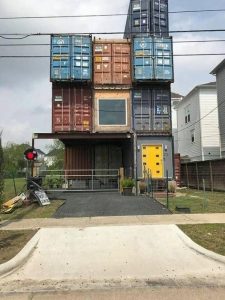For many people, building a dream home is just that—a dream. But for designer Will Breaux, it became a bold and tangible reality. Instead of following traditional methods, Breaux took a route less traveled and constructed a one-of-a-kind home made entirely out of shipping containers. Located on McGowen Street in the heart of Houston, Texas, his innovative residence is built from a total of 11 repurposed containers. The result is a modern, three-story home that spans approximately 2,500 square feet and even includes a rooftop deck, making it not only functional but also visually striking and architecturally intriguing.

Breaux’s journey to homeownership wasn’t simple, and it certainly wasn’t quick. He had dreamed of building his own home for years—since the early 2000s, in fact. However, as with many ambitious visions, the execution was complicated. Despite his strong desire to bring this idea to life, he struggled to find architects or designers who truly understood or shared his vision. Time and time again, plans didn’t quite match his expectations, either falling short creatively or not offering the design flexibility he needed. After several disappointments and failed collaborations, Breaux finally made a decision that would shape the rest of his journey: he was going to take full control of the process and design the home himself.
In 2011, Breaux officially began laying the groundwork for what would become his dream home. He started by researching other container home projects that inspired him. As he dove deeper into the world of alternative housing, the idea of using shipping containers increasingly made sense. For Breaux, it wasn’t just about doing something different; there were practical reasons, too. Shipping containers, originally built to withstand harsh conditions at sea, are incredibly strong and long-lasting. They’re fire-resistant, highly durable, and designed to handle extreme weather, including hurricanes—an especially valuable trait in storm-prone Texas. Breaux saw the containers not only as a creative building material but also as a smart and sustainable alternative to conventional home construction.
Despite having no formal background in architecture or construction, Breaux wasn’t discouraged. Instead, he rolled up his sleeves and started teaching himself everything he could about container homes. He poured over articles, videos, and building codes. In time, he developed his own digital blueprints and produced a detailed 3D sketch of the house he wanted to build. While it may have seemed unconventional or even impossible to some, Breaux was determined to prove that with enough passion, determination, and research, he could bring this project to life.
The process of designing and building a home from shipping containers came with its own set of challenges. Fitting everything together, ensuring structural integrity, and creating a comfortable living environment required meticulous planning. Breaux spent countless hours fine-tuning his design, making sure that every square inch of space would be utilized efficiently. The design had to account for plumbing, electrical systems, insulation, and ventilation—none of which are standard features in a shipping container. But Breaux approached each obstacle as an opportunity to learn and innovate. Instead of being intimidated by the complexity, he leaned into the experience, growing more confident with each new hurdle he overcame.
Eventually, after years of planning and hands-on learning, Breaux succeeded. His shipping container home wasn’t just a makeshift structure—it was a polished, modern dwelling, complete with stylish interiors and a fully furnished layout. It included everything you’d expect from a traditional home: bedrooms, bathrooms, a kitchen, living areas, and outdoor space. The rooftop deck, a favorite feature, offers sweeping views of the Houston skyline and serves as a perfect spot to relax or entertain guests.
Breaux’s home is more than just a personal accomplishment—it’s a bold statement about what’s possible when creativity meets determination. His project challenges the status quo and proves that beautiful, livable homes don’t have to be built with wood and bricks alone. It also opens the door to broader conversations about sustainability, urban housing, and adaptive reuse. By choosing to build with shipping containers, Breaux gave new life to discarded industrial materials that might otherwise sit unused in a shipyard. In doing so, he highlighted the potential of upcycled architecture and sparked interest in eco-conscious construction methods.
Breaux didn’t keep his journey to himself, either. Through blog posts and social media updates, he has documented every step of the process, sharing insights, lessons, and progress photos. His transparency has inspired countless others who are interested in alternative housing or self-build projects. For those who feel limited by traditional building paths or discouraged by high housing costs, Breaux’s story provides hope. It shows that with persistence and a willingness to learn, it’s possible to create a unique and functional space that truly reflects your personal style.
Today, Breaux lives in his container home, and he continues to tweak and improve it over time. While the major construction is complete, a home like this is always a work in progress. He’s constantly exploring new design ideas, materials, and technologies that can enhance the space further. What’s clear, though, is that Breaux didn’t just build a house—he built a symbol of resourcefulness and vision. It stands as proof that you don’t need a construction crew or millions of dollars to make something extraordinary. Sometimes, all it takes is a clear idea, a lot of determination, and the courage to try something different.
In the end, Will Breaux turned a dream into reality by refusing to settle. He didn’t follow a blueprint written by someone else. Instead, he wrote his own—one container at a time. His story is not just about architecture or alternative housing; it’s about belief, grit, and the drive to create something meaningful on your own terms.





